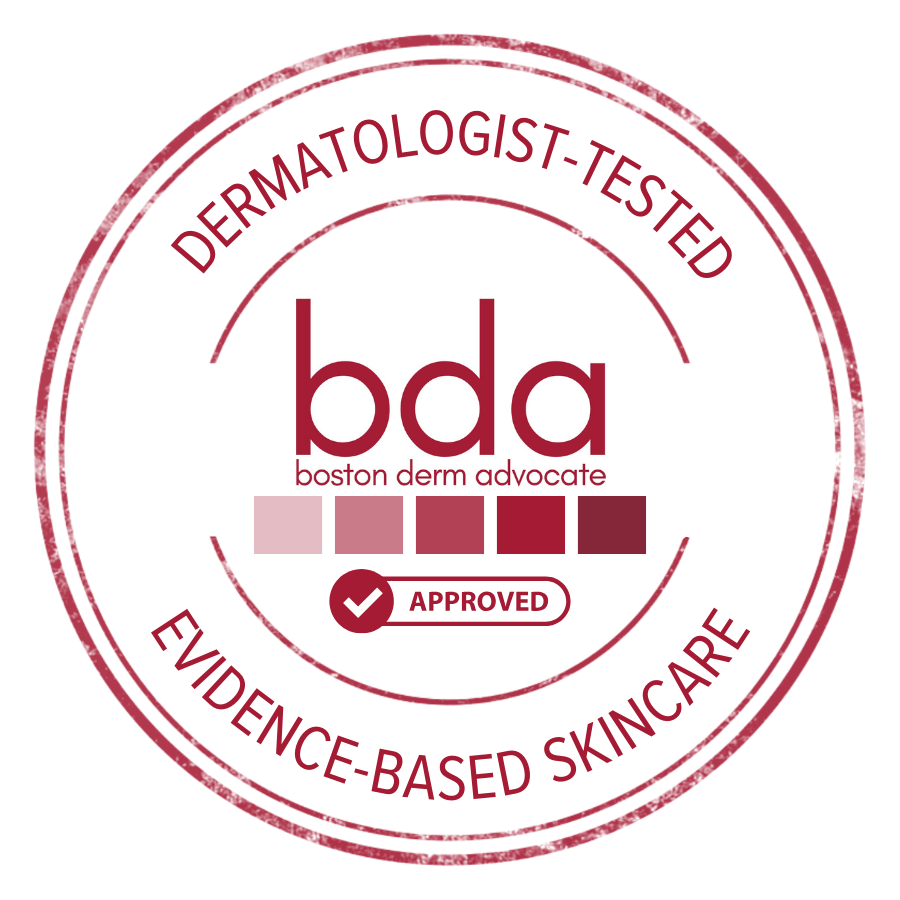Everything You Need to Know About Dandruff and Seborrheic Dermatitis, by Dermatologists
By J. Michael Yardman-Frank, MD, MPH and David G. Li, MD, MBA
J. Michael Yardman-Frank is a current dermatology resident at the Harvard Medical School Combined Dermatology Program. His interests include public health, dermatoepidemiology, and improving access to dermatological care for under-served communities.
David Li is a board-certified dermatologist in private practice in downtown Boston and the Founder of BDA. Previously he was a resident at the Harvard Medical School Combined Dermatology Program.
Table of Contents
What Exactly Are Dandruff and Seborrheic Dermatitis?
Who Develops Seborrheic Dermatitis?
What are Signs and Symptoms of Seborrheic Dermatitis?
How do Dermatologists Diagnose Seborrheic Dermatitis?
Best Medicated Treatments for Seborrheic Dermatitis
Can Seborrheic Dermatitis Spread to Other People?
If your scalp is snowing white flakes or your eyebrows look red and patchy, you may be dealing with dandruff or seborrheic dermatitis. Understanding the difference and getting proper diagnosis from a dermatologist is key for finding the right treatment. This article covers everything you need to know about recognizing, managing and preventing these common skin conditions.
What Exactly Are Dandruff and Seborrheic Dermatitis?
Dandruff refers to white, oily flakes of dead skin shedding from your scalp. It can cause mild itching but is harmless overall.
Seborrheic dermatitis is a common inflammatory skin disorder resulting in a red, sometimes greasy rash that is often accompanied by yellowish flakes. It is the disease process responsible for dandruff. It most often affects the scalp, but can occur on the face, ears, chest, back and other oily areas of the body. Seborrheic dermatitis causes more pronounced itching, redness, scaling and irritation than dandruff.
What Causes These Conditions?
The exact mechanisms behind dandruff and seborrheic dermatitis are not entirely known. Contributing factors are believed to include:
A yeast called Malassezia – This yeast normally lives on everyone’s scalps without issue. Yet, overgrowth of Malassezia is strongly associated with worsening seborrheic dermatitis and dandruff. The yeast produces inflammatory substances and feeds on scalp oils.
Oily skin – An excess of oils known as sebum on the skin appear to enable overgrowths of Malassezia, making oily areas more vulnerable to seborrheic dermatitis.
Impaired skin barrier – Problems with skin cell turnover and the protective outer layer of skin may also play a role.
Stress – Emotional stress can worsen symptoms for some individuals.
While dandruff and mild seborrheic dermatitis may come and go, more severe seborrheic dermatitis is often chronic with periodic flares. Treating the inflammatory nature is key for long-term management.
Who Develops Seborrheic Dermatitis?
Seborrheic dermatitis can affect people of any age, even infants. Certain groups at increased risk include:
Infants age 3-12 months with cradle cap
Adults between ages 30-60 years old
People with oily skin types
Individuals with HIV/AIDS, Parkinson's disease, mood disorders and neurological illnesses
Those with a family history of seborrheic dermatitis or dandruff
Patients using medications like lithium, interferon and certain chemotherapy drugs
What are Signs and Symptoms of Seborrheic Dermatitis?
Signs and symptoms of seborrheic dermatitis include:
Red, greasy skin covered by flaky, yellow-white scales
Moderate to severe itching
Dry skin
Tingling or burning sensation
Tenderness, soreness
Hair loss around affected areas like the eyebrows
Symptoms may wax and wane in severity. They often flare due to various triggers like seasonal changes, emotional stressors, fatigue, infrequent shampooing, alcohol consumption, hormone shifts and skin irritation. Catching and treating flares early helps minimize symptoms faster.
Where Does Seborrheic Dermatitis Appear?
In infants, seborrheic dermatitis mostly appears as cradle cap - characterized by thick, yellow, scaly patches on the scalp. Cradle cap often goes away naturally around 12-14 months old without treatment.
On adolescents and adults, seborrheic dermatitis frequently occurs on the:
Scalp
Eyebrows
Nose
Ears
Upper back
Chest
Facial involvement may appear as red, greasy patches with white flakes visible on the eyebrows, eyelids, sides of the nose, ears and beard area in men. Symptoms range from mild dandruff to disfiguring, crusty plaques extending onto the neck or upper back if more severe.
How do Dermatologists Diagnose Seborrheic Dermatitis?
Making an accurate seborrheic dermatitis diagnosis involves a full history and clinical inspection of your skin. The dermatologist evaluates:
Areas of involvement
Overall characteristics and severity of flaking/scaling
Presence of inflammation
Skin color changes
Distribution patterns – seborrheic dermatitis often appears symmetrically on both sides of the body
Potential involvement of other family members
They may also discuss any recent life stressors, skin care habits or topical product use that could be contributing to your flare.
In some cases, additional testing helps rule out conditions like:
Fungal infections
Psoriasis
Allergic reactions
Other dermatitis varieties
Although for classical presentations of seborrheic dermatitis, visual inspection alone usually suffices for an accurate diagnosis. It is also important to note that some patients with seborrheic dermatitis have an overlap with psoriasis known as sebopsoriasis. These patients may have a more aggressive form of disease and should establish care with a dermatologist to ensure optimal treatment.
Best Medicated Treatments for Seborrheic Dermatitis
Successfully managing seborrheic dermatitis involves treating inflammation and preventing recurrent flares. The most effective treatments dermatologists prescribe to accomplish this include:
1. Antifungal and Keratolytic (Scale Reducing) Shampoos (No Prescription Needed)
Antifungal shampoos containing ketoconazole, zinc pyrithione or selenium sulfide help reduce fungal overgrowth and skin inflammation. Using an anti-dandruff shampoo containing one of these ingredients daily to a few times per week provides first-line treatment for seborrheic dermatitis of the scalp. Proper use typically requires allowing the shampoo to sit on the hair and scalp for ~5 minutes before rinsing out.
Keratolytic shampoos are the other half of the equation for most patients. Antifungal shampoos reduce yeast and can help with inflammation in the scalp. However, the flaking continues to persist and can cling to the hair shafts or the top of the scalp. This is where a keratolytic shampoo that removes scale can be helpful.
Ideal regimen that we recommend in clinic:
M, W, F - Nizoral shampoo. Leave in 5 min. Rinse.
T, Th, Sat - T Sal shampoo. Leave in 5 min. Rinse.
2. Topical Corticosteroids (requires prescription)
Corticosteroid creams or ointments like desonide, hydrocortisone, and mometasone efficiently relieve inflammatory symptoms like redness, scaling, itching and tenderness. Medium potency topical steroids applied daily or twice daily effectively treat flare-ups of seborrheic dermatitis on the face and body. These medications should not be used continuously though and it is important to decrease their frequency once the symptoms are improving.
3. Antifungal + Steroid Combinations (requires prescription)
Combining an antifungal and topical medications (steroid, calcineurin inhibitor, or PDE-4 inhibitor) is frequently done for moderate to severe cases and can improve treatment outcomes. First apply ketoconazole cream, for example, followed by a topical medication as above. The antifungal tackles excess yeast while the other topical cream fights inflammation. This combination keeps many cases under excellent control long-term.
4. Oral Antifungals (requires prescription)
For more severe, extensive seborrheic dermatitis cases not responding sufficiently to topical treatments alone, oral antifungals like fluconazole (weekly dosing) may be warranted. These oral medications help reduce fungal overgrowth but may have increased side effects.
Will Seborrheic Dermatitis Go Away Permanently?
For infants with cradle cap, the condition often resolves without treatment by 12-14 months old. In adolescents and adults, seborrheic dermatitis tends to be a chronic, lifelong condition - meaning it may persist throughout life, frequently with large time variations in severity. Ongoing preventative treatment is often needed to keep recurring symptoms at bay.
Can Seborrheic Dermatitis Spread to Other People?
No - seborrheic dermatitis is not contagious. It results from overgrowth of malassezia yeast naturally found on everyone’s bodies. You cannot spread seborrheic dermatitis to other people via direct contact, clothing, brushes or towels.
However, some families appear to have a genetic predisposition for the condition. As such, it is important to know that patient’s relatives may be more prone to developing seborrheic dermatitis compared to the general population.
Tips for Managing Seborrheic Dermatitis Long-Term
Successfully keeping seborrheic dermatitis flare-ups at bay involves identifying and avoiding your unique triggers combined with a consistent skincare regimen using medicated anti-dandruff shampoos and/or steroid treatments.
Helpful tips for minimizing flare triggers include:
Lower emotional stress levels with regular exercise, meditation, yoga, etc.
Avoid skin irritants like hair sprays, hair dyes and harsh soaps
Limit alcohol consumption which can worsen symptoms
Shampoo hair frequently enough – at least 2-3 times a week
Take brief, lukewarm showers instead extremely hot water
Limit outdoor time in cold, dry weather
Stick to gentle skin care and cosmetics labelled non-comedogenic and fragrance/dye free products
-
What is seborrheic dermatitis?
Seborrheic dermatitis, also known as seborrheic dermatitis, is a common skin condition that causes redness, scaly patches, and dandruff. It can occur on the scalp, face, and other areas of the body.
What causes seborrheic dermatitis?
The exact cause of seborrheic dermatitis is not known, but it is believed to be related to an overgrowth of a type of yeast that is normally found on the skin. Other factors such as stress, cold and dry weather, and certain medical conditions may also contribute to its development.
How is seborrheic dermatitis treated?
To treat seborrheic dermatitis, skincare products containing ingredients like ketoconazole, selenium sulfide, or pyrithione zinc can be used. Additionally, medicated shampoos and topical corticosteroids may be prescribed by a dermatologist to help manage the symptoms.
Can seborrheic dermatitis affect patients with skin of color?
Seborrheic dermatitis can affect individuals with darker skin as well. However, the condition may appear differently in terms of color and texture, making diagnosis and treatment an important consideration.
What is the treatment plan for seborrheic dermatitis?
A dermatologist may develop a treatment plan for seborrheic dermatitis based on the severity and location of the condition. This may involve a combination of medicated shampoos, topical treatments, and skincare routines tailored to the individual's needs.
Is seborrheic dermatitis a form of eczema?
Yes, seborrheic dermatitis is considered to be a form of eczema. Both conditions involve inflammation of the skin, but they have distinct features and are often managed differently.
How is seborrheic dermatitis different from atopic dermatitis?
Atopic dermatitis is a chronic, skin disease that causes inflamed, itchy skin. It's also known as eczema. In contrast, seborrheic dermatitis mainly affects oily areas of the body and is characterized by scaly patches and red skin.
Can seborrheic dermatitis lead to skin cancer?
There's no direct link between seborrheic dermatitis and skin cancer. However, persistent redness and inflammation caused by seborrheic dermatitis might mimic the appearance of certain types of skin cancer. If you have any concerns, it's essential to seek a skin biopsy to rule out any serious conditions.
What are the treatment options for seborrheic dermatitis?
Treatment of seborrheic dermatitis aims to reduce inflammation and control the symptoms. It includes the use of dandruff shampoo, topical antifungal creams, and corticosteroids. In severe cases, a dermatologist might prescribe oral medications or light therapy.
Is it necessary to see a dermatologist for seborrheic dermatitis?
If seborrheic dermatitis is persistent or causing discomfort, it's advisable to see a dermatologist. A dermatologist can provide a skin biopsy for a correct diagnosis and recommend a suitable treatment plan for your affected skin.
How does seborrheic dermatitis on the face manifest?
Seborrheic dermatitis on your face may appear as red, scaly patches, particularly in areas with more oil glands, such as the eyebrows, sides of the nose, and around the mouth. This condition is also known as facial seborrheic dermatitis.
-
We are a group of dermatology residents and attending physicians based in Boston, MA. Our team of Ivy League-trained dermatologists is demystifying the cosmeceutical industry by offering unbiased, scientifically supported reviews of skincare products. We are extremely passionate about skincare and making it accessible to all through education. We value integrity, practicality, and inclusivity. No sponsorships were received for the products prior to testing; we feel strongly about providing un-biased reviews. After blogs are published, following the links in this blog post may result in commission.



